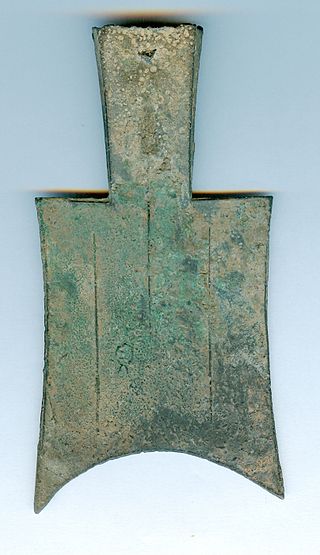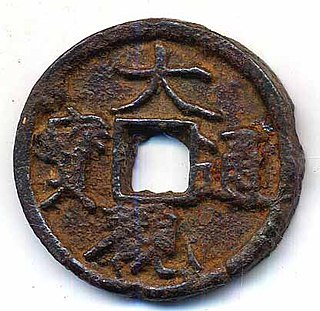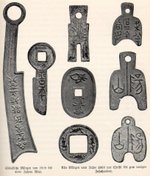
A coin is a small object, usually round and flat, used primarily as a medium of exchange or legal tender. They are standardized in weight, and produced in large quantities at a mint in order to facilitate trade. They are most often issued by a government. Coins often have images, numerals, or text on them. The faces of coins or medals are sometimes called the obverse and the reverse, referring to the front and back sides, respectively. The obverse of a coin is commonly called heads, because it often depicts the head of a prominent person, and the reverse is known as tails.

Rupee is the common name for the currencies of India, Mauritius, Nepal, Pakistan, Seychelles, and Sri Lanka, and of former currencies of Afghanistan, Bahrain, Kuwait, Oman, the United Arab Emirates, British East Africa, Burma, German East Africa, and Tibet. In Indonesia and the Maldives, the unit of currency is known as rupiah and rufiyaa respectively, cognates of the word rupee.

The history of Chinese currency spans more than 3000 years. Currency of some type has been used in China since the Neolithic age which can be traced back to between 3000 and 4500 years ago. Cowry shells are believed to have been the earliest form of currency used in Central China, and were used during the Neolithic period.

The Ban Liang was the first unified currency of the Chinese empire, first minted as early as 378 BCE and introduced by the first emperor Qin Shi Huang as China's first unified currency around 210 BC. It was round with a square hole in the middle. Before that date, a variety of coins were used in China, usually in the form of blades or other implements, though round coins with square holes were used by the State of Zhou before it was extinguished by Qin in 249 BCE.

A sycee or yuanbao was a type of gold and silver ingot currency used in imperial China from its founding under the Qin dynasty until the fall of the Qing in the 20th century. Sycee were not made by a central bank or mint but by individual goldsmiths or silversmiths for local exchange; consequently, the shape and amount of extra detail on each ingot were highly variable. Square and oval shapes were common, but boat, flower, tortoise and others are known. Their value—like the value of the various silver coins and little pieces of silver in circulation at the end of the Qing dynasty—was determined by experienced moneyhandlers, who estimated the appropriate discount based on the purity of the silver and evaluated the weight in taels and the progressive decimal subdivisions of the tael.
Japanese currency has a history covering the period from the 8th century AD to the present. After the traditional usage of rice as a currency medium, Japan adopted currency systems and designs from China before developing a separate system of its own.

Ancient Chinese coinage includes some of the earliest known coins. These coins, used as early as the Spring and Autumn period (770–476 BCE), took the form of imitations of the cowrie shells that were used in ceremonial exchanges. The same period also saw the introduction of the first metal coins; however, they were not initially round, instead being either knife shaped or spade shaped. Round metal coins with a round, and then later square hole in the center were first introduced around 350 BCE. The beginning of the Qin dynasty (221–206 BCE), the first dynasty to unify China, saw the introduction of a standardised coinage for the whole Empire. Subsequent dynasties produced variations on these round coins throughout the imperial period. At first the distribution of the coinage was limited to use around the capital city district, but by the beginning of the Han dynasty, coins were widely used for such things as paying taxes, salaries and fines.

The term tiền is used to refer to various currency-related concepts used in Vietnamese history. The name is a cognate with the Chinese qián (錢), a unit of weight called "mace" in English. It can refer to a unit of weight used in precious metal coinages as well as the number of cash coins in a string. The name was also used for different awards, both Chinese-style and Western-style awards given in Vietnam throughout different times of its history.

The cash or qian was a type of coin of China and the Sinosphere, used from the 4th century BC until the 20th century AD, characterised by their round outer shape and a square center hole. Originally cast during the Warring States period, these coins continued to be used for the entirety of Imperial China. The last Chinese cash coins were cast in the first year of the Republic of China. Generally most cash coins were made from copper or bronze alloys, with iron, lead, and zinc coins occasionally used less often throughout Chinese history. Rare silver and gold cash coins were also produced. During most of their production, cash coins were cast, but during the late Qing dynasty, machine-struck cash coins began to be made. As the cash coins produced over Chinese history were similar, thousand year old cash coins produced during the Northern Song dynasty continued to circulate as valid currency well into the early twentieth century.

Spade money was an early form of coin and commodity money used during the Zhou dynasty of China. Spade money was shaped like a spade or weeding tool, but the thin blade and small sizes of spade money indicate that it had no utilitarian function. The earlier versions of spade coins tended to have a fragile, hollow socket, reminiscent of a metal shovel. Later versions of spade money had this socket was transformed into a thin, flat piece, and over time, inscriptions were added to the spade coins to mark their denominations. Several versions of spade money circulated across the Chinese Central Plains during the Zhou dynasty period until they were abolished by the Qin dynasty in 221 BC in favour of the Ban Liang cash coins.

The Yuan dynasty was a Mongol-ruled Chinese dynasty which existed from 1271 to 1368. After the conquest of the Western Xia, Western Liao, and Jin dynasties they allowed for the continuation of locally minted copper currency, as well as allowing for the continued use of previously created and older forms of currency, while they immediately abolished the Jin dynasty's paper money as it suffered heavily from inflation due to the wars with the Mongols. After the conquest of the Song dynasty was completed, the Yuan dynasty started issuing their own copper coins largely based on older Jin dynasty models, though eventually the preferred Yuan currency became the Jiaochao and silver sycees, as coins would eventually fall largely into disuse. Although the Mongols at first preferred to have every banknote backed up by gold and silver, high government expenditures forced the Yuan to create fiat money in order to sustain government spending.

Nagasaki trade coins (長崎貿易銭), also known as Nagasaki export coins refer to Japanese mon coins specifically cast for export by the Tokugawa government between 1659 and 1685 during the Sakoku era. Though the inscriptions on the coins often match Chinese coins from the Song dynasty they’re often cast with different typefaces such as the fact that the Genpō Tsūhō (元豊通寳) produced at Nagasaki was in Clerical script while the Song dynasty’s versions were in Seal script and Running script. Due to the success of these coins they’re often still found in modern day Vietnam and Java, and were copied by contemporary Vietnamese mints as they had become the de facto standard coinage in Vietnam as native production had declined in the 17th century. As the export of gold and silver was banned by the Qing dynasty Japanese merchants were most likely to go to Hanoi and Hội An to gain access to Chinese products causing these coins to start circulating en masse on the Vietnamese market. A special “5 elements” series of Nagasaki trade coins were also cast for export to Taiwan.

Qing dynasty coinage was based on a bimetallic standard of copper and silver coinage. The Manchu-led Qing dynasty was established in 1636 and ruled over China proper from 1644 until it was overthrown by the Xinhai Revolution in 1912. The Qing dynasty saw the transformation of a traditional cash coin based cast coinage monetary system into a modern currency system with machine-struck coins, while the old traditional silver ingots would slowly be replaced by silver coins based on those of the Mexican peso. After the Qing dynasty was abolished its currency was replaced by the Chinese yuan of the Republic of China.

The Han dynasty coinage system refers to the currency system of the Han dynasty, which ruled China from 202 BC until 9 AD, when it was overthrown by the Xin dynasty, and again from 25 AD until 220 AD. The most common coin used during the Han dynasty period was the bronze cash coin, while smaller quantities of gold coinages also circulated. During the reign of Emperor Wu in 119 BC a series silver-tin alloy coins was introduced, but due to both unforseen inflationary effects and rampant counterfeiting it was withdrawn after circulating for only 4 years. The Han dynasty period saw an average annual production of 220,000,000 bronze cash coins minted. The Han dynasty saw the introduction of the Wu Zhu (五銖) inscription on cash coins, which would be used for a total 736 years centuries after the end of the Han dynasty, until it was replaced by the Kaiyuan Tongbao (開元通寳) inscription in 621 AD during the Tang dynasty period.

The Kaiyuan Tongbao, sometimes romanised as Kai Yuan Tong Bao or using the archaic Wade-Giles spelling K'ai Yuan T'ung Pao, was a Tang dynasty cash coin that was produced from 621 under the reign of Emperor Gaozu and remained in production for most of the Tang dynasty until 907. The Kaiyuan Tongbao was notably the first cash coin to use the inscription tōng bǎo (通寶) and an era title as opposed to have an inscription based on the weight of the coin as was the case with Ban Liang, Wu Zhu and many other earlier types of Chinese cash coins. The Kaiyuan Tongbao's calligraphy and inscription inspired subsequent Central Asian, Japanese, Korean, Ryūkyūan, and Vietnamese cash coins and became the standard until the last cash coin to use the inscription "通寶" was cast until the early 1940s in French Indochina.

Vault Protector coins were a type of Chinese numismatic charm coins created by Chinese mints. These coins were significantly larger, heavier and thicker than regular cash coins and were well-made as they were designed to occupy a special place within the treasury of the mint. The treasury had a spirit hall for offerings to the gods of the Chinese pantheon, and Vault Protector coins would be hung with red silk and tassels for the Chinese God of Wealth. These coins were believed to have charm-like magical powers that would protect the vault while bringing wealth and fortune to the treasury.

Wu Zhu is a type of Chinese cash coin produced from the Han dynasty in 118 BC when they replaced the earlier San Zhu cash coins, which had replaced the Ban Liang (半兩) cash coins a year prior, until they themselves were replaced by the Kaiyuan Tongbao (開元通寳) cash coins of the Tang dynasty in 621 AD. The name Wu Zhu literally means "five zhu" which is a measuring unit officially weighing about 4 grams however in reality the weights and sizes of Wu Zhu cash coins varied over the years. During the Han dynasty a very large quantity of Wu Zhu coins were cast but their production continued under subsequent dynasties until the Sui.

Iron cash coins are a type of Chinese cash coin that were produced at various times during the monetary history of imperial China as well as in Japan and Vietnam. Iron cash coins were often produced in regions where the supply of copper was insufficient, or as a method of paying for high military expenditures at times of war, as well as for exports at times of trade deficits.

Chinese burial money a.k.a. dark coins are Chinese imitations of currency that are placed in the grave of a person that is to be buried. The practice dates to the Shang dynasty when cowrie shells were used, in the belief that the money would be used in the afterlife as a bribe to Yan Wang for a more favourable spiritual destination. The practice changed to replica currency to deter grave robbers, and these coins and other imitation currencies were referred to as clay money (泥錢) or earthenware money (陶土幣).





















